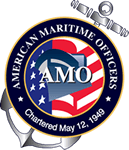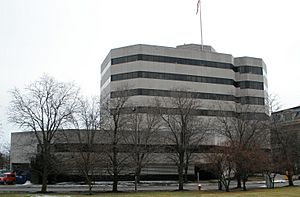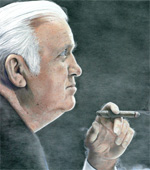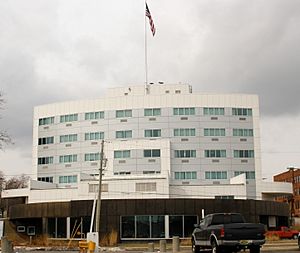American Maritime Officers facts for kids
 |
|
| Founded | May 12, 1949 |
|---|---|
| Headquarters | Dania Beach, Florida |
| Location | |
|
Members
|
3,082 (2014) |
|
Key people
|
Paul Doell |
The American Maritime Officers (AMO) is a special group, like a club for workers, called a labor union. It's part of a bigger group called the Seafarers International Union of North America. About 4,000 people are members of AMO.
AMO helps licensed mariners, who are like trained sailors, who work on American ships. These ships include merchant ships (for trade) and military ships. AMO is also important in carrying energy, like oil and gas, around the world.
AMO members work on many different kinds of ships. These include oil tankers, container ships, and ships that carry large vehicles. They also work on special ships that install and fix underwater cables.
AMO officers also work on ships for the Military Sealift Command. These ships help the military by carrying supplies and equipment.
AMO has helped create new jobs for American officers on ships that travel all over the world. This includes ships that carry liquefied natural gas (LNG).
The AMO Safety & Education Plan runs a place called the STAR Center. Here, AMO officers can get special training. This includes the only LNG training program in the U.S. that meets high international standards. This training helps AMO officers work on ships from many different countries.
At the STAR Center, AMO officers can also learn about "dynamic positioning" (DP). This is a special skill for keeping a ship in one place using its own engines.
AMO also represents officers and stewards on most ships in the Great Lakes. They also work on many tugboats and other boats on rivers and canals.
AMO members and their families get important benefits from the union. These include medical care, vacation time, and retirement plans. These benefits are paid for by the employers.
The AMO Safety & Education Plan gives AMO members and new applicants training. This training helps them get their licenses and learn new skills at the STAR Center in Dania Beach, Florida. This training, including places to stay and food, is free for AMO officers. There used to be a STAR Center in Ohio, but it closed in 2008.
History of AMO

AMO started on May 12, 1949. It was part of the Seafarers International Union of North America. Back then, it was called the Brotherhood of Marine Engineers. A famous labor leader named Paul Hall helped create it. The first members were sailors who had served in World War II.
In 1953, the Brotherhood of Marine Engineers became more independent. This meant they could create their own rules and choose their own leaders.
The first rules were written by several members. They wanted fair elections and clear duties for union leaders. They also wanted members to be able to see the union's money records. Most members voted to accept these rules. Wilbur Dickey was chosen as the first president on December 15, 1953.
In September 1954, a large group called the American Federation of Labor (AFL) recognized the new union. This meant the union was the official group for engine room officers on ships.
The union also started a plan to help members with their health. By August 1954, this plan had over $100,000. It offered good benefits, like full surgery coverage for members and their families. In 1955, the union started working on a retirement plan for officers.
In 1957, Wilbur Dickey stepped down as president. Ray McKay took over on January 17, 1957. Later that year, AMO joined with some parts of another union called the Marine Engineers' Beneficial Association. This new group was called "District 2 MEBA."
In 1992, "District 2" changed its name back to "American Maritime Officers." In 1994, AMO left MEBA. It rejoined the Seafarers International Union of North America in 2004.
Today, AMO is a strong national union. It represents licensed officers on many types of ships in the U.S. fleet. This includes ships on the ocean, the Great Lakes, and inland rivers. It also includes ships that help the military and those that carry energy around the world.
Tom Bethel became the national president of AMO in June 2008. He had been the national executive vice president before that.
Great Lakes Work Stoppage of 2007
On May 9, 2007, AMO members stopped working for the Wisconsin & Michigan Steamship Company. This was about three ships on the Great Lakes. These ships were the M/V David Z, the M/V Earl W, and the M/V Wolverine.
These ships belonged to the Wisconsin and Michigan Steamship Company. The company is part of Sand Products Corp. The ships were bought in 2006. They were used by another company, Lower Lakes Transportation Co.
The work stoppage happened because the company would not agree to a standard contract. The union said that job security and benefits were the main problems. AMO members, including deck officers, marine engineers, and stewards, left the ships on May 10, 2007. This caused delays for the Wolverine.
The ships stayed still in Sarnia, Ontario for some time. The work stoppage cost the company a lot of money. The agreement for these ships ended in July 2007. All three ships were sold in 2008. One of them, the Wolverine, was later moved to Canada.
AMO Presidents
- Charles King (1953)
- Wilbur Dickey (1953 – January 19, 1957)
- Raymond McKay (January 19, 1957 – 1993)
- Michael McKay (1993 – January 8, 2007)
- Tom Bethel (January 8, 2007 – December 31, 2014)
- Paul Doell (January 1, 2015 – present)



